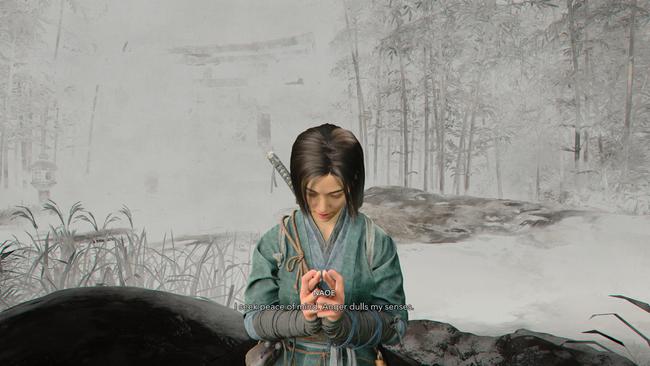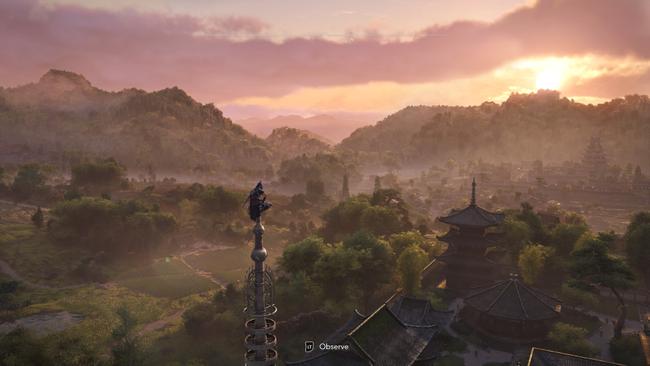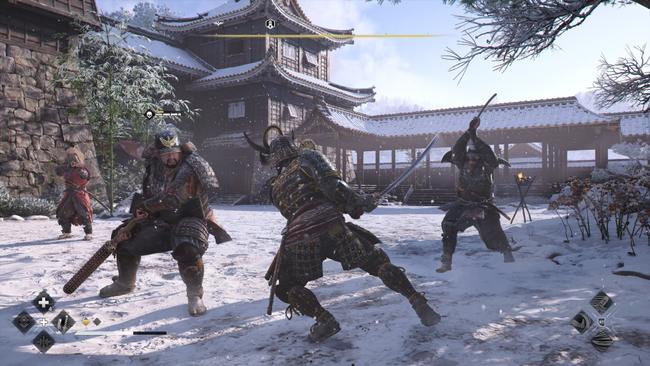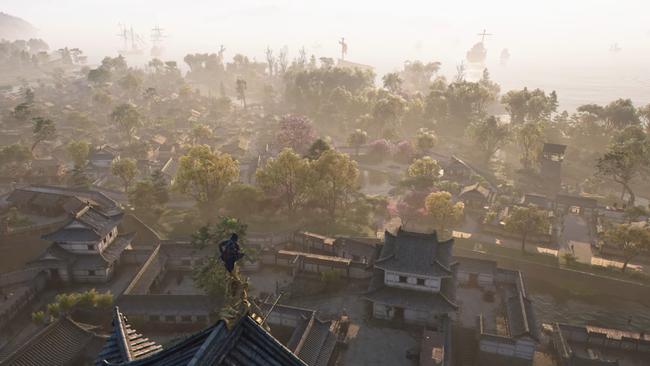
Assassin's Creed Shadows Review
Before I begin my review of Assassin's Creed Shadows, here's a joke I was once told by a friend from Japan who worked as a guide for English-speaking tourists: How do you know when your Japanese tour guide has run out of things to say? When they start talking about how Japan "has four seasons." He was referring to the popular myth that while most temperate countries have four seasons, Japan is distinct in having highly differentiated, even extreme variation between those seasons.
In the popular imagination, the whole Japanese landscape changes dramatically between seasons, moving from bleak, snowy winters to lush, blooming springs, to sweltering, humid summers to serene, burning-red autumns. I mention this joke because it happens to be a point that developer Ubisoft took to heart when it put together Assassin's Creed Shadows' environments. For Shadows, those seasonal transitions are a way for the game to mark the passage of time. Every couple of hours of time spent in-game, the season changes, plunging the whole map into a vividly rendered version of the seasonal landscape.

Speaking of the passage of time, this review took quite a lot of it to put together. Back when the game launched in March 2025, I delivered my early impressions of its opening chapters, but for various reasons, I wasn't in a position to rush through Shadows in an attempt to get it done as quickly as possible. So I took a cue from Adam's late Assassin's Creed Valhalla review approach, opting to take it slow and appreciate Shadows as an ordinary player might, rather than rushing to the finish like a game reviewer trying to hit an embargo. It turns out that was the right decision. Assassin's Creed Shadows is at its best when it's taken in a series of "meals" spread out over a long time, rather than binged as a single massive feast. I wouldn't be surprised if Ubisoft had intended for Shadows' carefully timed seasonal rhythm to also serve as a soft, diegetic timer for the ideal session length. The lushly rendered CG videos that bookend each season make for great start/stop reminders for the day's memorable adventures in feudal Japan.
Back when I closed out my early impressions, I was deep in the initial story chapter, a propulsive series of missions focused entirely on the activities of budding shinobi Naoe. At the time, I had not even met Yasuke, the game's second protagonist, and was somewhat worried that, like Origins and Odyssey, the familiar monotony of this style of game and its sheer scale would set in before I'd get to see Shadows' take on one of Japan's most intriguing figures.

As it turns out, Yasuke not only represents a fascinating angle on the traditional Assassin's Creed approach to historical fiction, but his presence also a useful game design bulwark against the sameyness that tends to set in with open-world "map games." This is because between them, Naoe and Yasuke represent two differing approaches to Assassin's Creed's gameplay, divided between two distinct characters (rather than unified in a single all-purpose protagonist). Naoe approaches missions from stealth, staying above the fray and silently clearing enemy hotspots as an invisible, undetectable killer - the classical image of a ninja. Her's are the missions most resembling "classic" Assassin's Creed as well as the more recent Mirage, which was something of a deliberate throwback to those days. By contrast, Yasuke barges straight in through the front gate, a force of nature that sweeps aside entire groups of enemies with a long katana, sharp polearm, a massive kanabo club, and the most satisfying front kick attack since Duke Nukem's Mighty Boot. Playing as Yasuke felt like running in the sandals of Bayek, Cassandra, or Eivor, the leads of the more combat-focused, RPG-driven latter-day Assassin's Creed games.
This isn't to say that Yasuke and Naoe make playing Assassin's Creed Shadows feel like two entirely different games. Both control in basically the same way, and are technically capable of doing both stealth and combat approaches. Naoe can definitely fight - she becomes a veritable human blender once you master her kusarigama skills - but she'll never break open a locked gate with her shoulder or kick someone into the horizon. Similarly, Yasuke can sneak and climb and do a "stealth kill," but he'll never match Naoe's agility or, for that matter, be able to cross one of the many suspended tightropes crisscrossing Japan's rooftops. This sort of forced specialization in Shadows restores the sense of distinctive character Assassin's Creed Origins and the rest tended to lose in the rapid powering-up that skill trees and gear perks gave to its solo leads.

The dual protagonists also get distinctive narrative treatments, though this difference isn't always an unalloyed positive. As a largely original character (though connected to real history by being the daughter of Fujibayashi Nagato), Naoe feels very much like the "true" protagonist of Shadows. She has the most direct connection to the core plot and the most investment in the fight against the Shinbakufu, the shadowy circle of baddies at the center of the chaos. Meanwhile, Yasuke's involvement in the narrative feels more peripheral, especially early on, due to his belated introduction. Many of his exclusive story missions center around his relationships with known historical figures, particularly with Oda Nobunaga and his inner circle. This isn't to say that Yasuke doesn't have a place, but that, as with gameplay, Assassin's Creed Shadows spreads its narrative and world-building duties across its two protagonists, with Naoe's perspective locked to the fight at hand against the Shinbakufu and Yasuke's sequences taken as an opportunity to paint a picture of life in the court of one of the Sengoku era's most famous warlords.
The narrative and sense of the world are made that much richer by the vividness of its environment. Even after months spent playing it since release and close to a hundred hours recorded in-game, Assassin's Creed Shadows remains one of the best-looking games I've played to date, with some of the most lavishly rendered landscapes I've seen. Whereas other period-set games like Ghost of Tsushima opt for a stylized presentation that may as well be fantasy art, Shadows leans in on its framing as historical fiction, looking to all the world like a real attempt to render what Japan might have looked like at the time. It was a real pleasure to visit well-known landmarks like Kyoto's Kyomizu-dera and Kinkakuji temple, or the castles at Osaka and Azuchi, and get a glimpse of what they might've looked like before urbanization and crowds of tourists permanently altered their image. Even outside the better-known locations, the foliage rendering in Shadows is world-beating, with the wind and light making the environment come alive in a way that underscores why so many Japanese folktales and horror story premises are set in the forest at night.

But as good and fresh as its presentation may feel, some familiar frustrations do eventually pop up. Even playing the game a little bit at a time, like I did, the repetition of different activities set in, with stronghold infiltrations and smaller mission types beginning to blend together into a shapeless mass of stealth, combat, and reward rather than the kind of epic ninja or samurai mission ransacking a castle full of enemies should feel like. The differences in layout and enemy composition between strongholds can add some variety, but eventually, the appeal of finding a new gear perk, or a piece of equipment, or hideout decoration loses its attractive appeal, and there will be many more strongholds to plunder. The Hideout construction subsystem feels mostly superfluous beyond a few useful game benefits, and it seems more like a way to sell cosmetics via the premium "Helix Credits" store. Admittedly, it is nice to be able to construct a fancy Japanese house and walk around it, even if it lacks things to do there.
And while the game's dual protagonist structure and the strength of its setting carry a lot of the atmosphere, Ubisoft's insistence on letting players go almost anywhere they please and tackle tasks and missions at their leisure regardless of their narrative weight remains seriously damaging to flow, just as it did in the other games of Assassin's Creed's RPG era. Even the visually impressive trick of using the passage of seasons to mark time ends up undermining the urgency of the narrative, particularly given that Shadows is set in a fairly specific, well-documented period of real history. Let's just say that if the seasons that passed in-game actually represented the real passage of time based on Shadows' setting, many of the people involved in the story would've died from historical circumstance rather than Naoe's blade, at the pace I was going.

This meandering pace has been a recurring problem ever since Origins went full open-world with its list of proto-Templars to kill, and while Assassin's Creed Shadows does a better job than Odyssey and Valhalla of containing that narrative sprawl - in part through the way its protagonists spread the story weight across multiple angles, the villains come across like a disjointed collection of unrelated baddies living in isolated strongholds spread through central Japan. In some cases, their connection with each other as members of the Shinbakufu feels no deeper than their collective appearance under a big circle on the kill list labeled "Shinbakufu." Some ostensibly major villains barely get more than a single cutscene to their "arc," and they rarely come across as any more threatening than, say, a particularly tricky set of stronghold guards. There are exceptions, of course, particularly notable historical personalities like Nobunaga's sister Oichi, but they're far less common than they should be in a game of this scale, and the overall lack of substance on the part of Naoe and Yasuke's opposition drains their mission of gravitas.
This sense of vague motivation, of doing things for their own sake and simply solving an individual province's problems rather than participating in a broader mission with a major goal, becomes more acute in light of how heavily deemphasized the modern-day plotline has become. The presence of the Assassin-Templar war in the background of Assassin's Creed has been a contentious issue among fans since the very first game, but I've always leaned more towards the faction that (or at least tolerated) that side of the series, as it provided a convenient metafictional skeleton to undergird these otherwise disconnected stories of near-superhuman murderers from across time and space. Unfortunately for modern-day plot-likers, the setup in Assassin's Creed Shadows beyond the initial premise is almost entirely confined to the game's equivalent of a seasonal pass, the Animus Hub "Projects." Clearly intended as a way to keep players hooked on the game after all the map icons have been hoovered up, Projects are the equivalent of the daily quests introduced in Origins, and they allow players to perform rotating mini-tasks that reward them with points that unlock new equipment sets, a trickle of "Keys" currency to use in a free item store. In the case of the first Project (called "The Legacy"), this hints at what's happening in the world outside the Animus. Mostly told in the form of text logs and ARG-style hints dropped in news updates and trailers, this seems to set up future stories, but largely lacks the impact of the actual playable sequences and comes across as too peripheral to truly buttress the broader series' story.

These complaints might seem familiar to some veterans of the Assassin's Creed series who have since fallen off the wagon. Indeed, Shadows doesn't solve some of the core issues with the series' design introduced in these later entries. At the same time, I feel like the fact that I did stick with Shadows all the way through and still found it fresh enough that I was inspired to try reconnecting with its predecessors (which I failed to stick with at the time), speaks to how well it has refined that formula. It has also managed to revive some of the focus and distinctive feel of the older titles in the series, and in doing so, recaptured some of what made Assassin's Creed one of my favorite titles of previous generations.